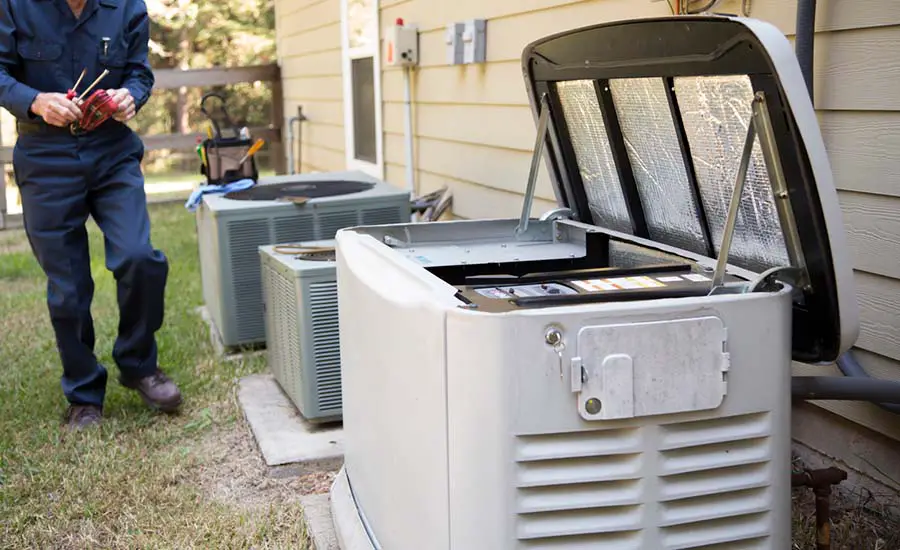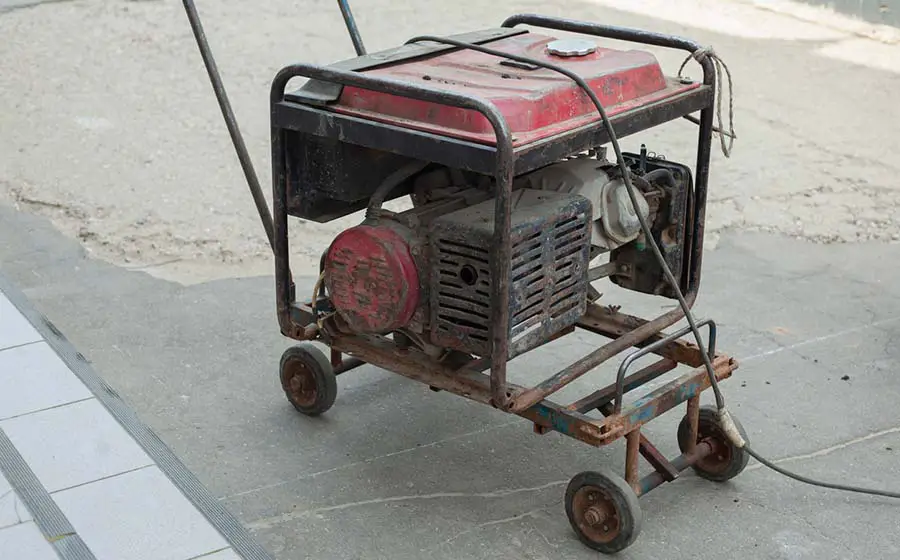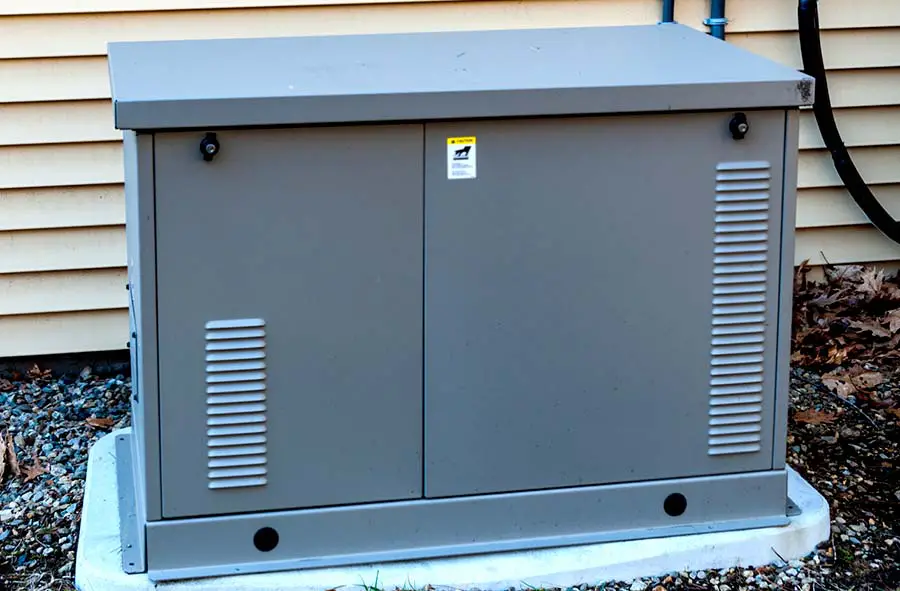
Your generator will most likely continue to work until it physically cannot move anymore, with many generators dying long before they should. These machines are pretty hardy, making many people think they need no maintenance, mainly if they rarely use them. However, if you have done even essential reading, you will know that all generators need care.
To keep your generator working correctly, check the air filter before every use, replace the air filter after every 100 hours of operation, and check the oil levels every two weeks. Running your generator for at least 20 minutes each month and keeping it clean is the best way to reduce maintenance.
These are just the basic things you should keep your generator going at full efficiency. Understanding what you will need to do, how to do it, and when to do each thing is integral to generator maintenance. Unlike car or bike engines, these motors are pretty simple, and you should be able to maintain the generator you have at home.
What Do You Need to Do When First Starting the Generator?
While we would all like to think that generators are plug and play straight out of their boxes, they never are, with most needing a breaking-in period before adequately being used. While the complexities of the breaking-in period are specific to each generator, some things are not.
Before you can even start the breaking-in process, there are a few basic steps that you will need to take to ensure the generator is ready.
We will be broadly speaking about three things that you will need to do, as these are the only things necessary to start your generator for the first time. Many people forget to do this to their generators, causing damage in most subsequent uses as the initial injury is multiplied over time. To ensure your generator is ready, you will need to check the fluids, check the filters, and read through the whole manual.
Filling the Fluids
There are two fluids in every generator, the fuel it needs to operate correctly and the oil that keeps everything adequately lubricated. A new generator will have no oil in it; you will need to buy the recommended oil from the manufacturer. You must also add the fuel the generator needs to the generator’s fuel tank; this needs to complete its internal combustion.
You must not add random fuel to your generator; many only use specific fuel types; these fuels burn at particular temperatures. You should be adding the correct oil and enough of it to ensure that every internal surface that requires it is adequately lubricated. Using the wrong fluids when the generator starts up will cause long-lasting damage and shorten its lifespan significantly.
Checking the Filters
If you are lucky, your generator will have every filter already in the right place; however, this is rare as the filters can be damaged when transported like this. When taking the generator out of the box, you will need to do some assembly; this includes unwrapping the filters, lubricating them to ensure proper sealing, and inserting them. This process should only take a few minutes to complete but can determine the overall quality of the fuel and oil in the generator.
You can screw in the oil filter by hand; over-torquing will cause thread damage; with the O-ring lubricated with fresh oil, you can use your finger to do this.
Fuel filters for generators can vary greatly. Small engines have only small, washable sponges or large screw-in filters with pipes coming in and out of them. The last filter you must install is the air filter, which can be a paper-like material or sponges as well.
Reading the Manual
Technically, this should be the first thing you are doing when opening the box of your generator. However, we know that the temptation to get it started will be hard to resist, so now that it is ready, we recommend giving it a read before starting it. The manual will tell you exactly how long you will need to run the generator to have it broken in, as well as what type of oil and fuel you should be using.
An excellent way to have your generator run perfectly is by following the step-by-step guide on how to do a first-time start with your generator. Every manufacturer has a slight variation in how they need their generators to be started the first time, sometimes having checks and things that you must do for the first few starts. The manual will always hold the truth in how you will need to treat your generator, even if you have been running it for multiple years.
What to Check Regularly on Your Generator?

After the generator has been started up for the first few times, you will need to start doing the work of constantly maintaining your generator. While it may be simple in theory, once your generator is a year or more old, these steps will make a big difference. Many people assume that some checks only need to be done once or twice a year; however, this is not true.
We are aware of four things that you need to check every few weeks if you are using your generator, with several that you must check each time you start the generator if you are regularly using it. These maintenance checks will ensure that your generator does not run on almost empty when it most needs lubrication or fuel, both of which can cause damage to the system.
The Air Filters
The main point of introduction for any dirt or dust into the generator system is the air intake, which should have a filter. Air filters are typically easy to check and clean as the manufacturers know the constant wear and tear they face. We have seen that when air filters are neglected, the entire generator usually starts to perform a lot worse. You must be checking on the filters in your generator for this reason.
You can clean smaller generators that use sponge-like air filters using gas, as you’re supposed to remove the sponge, clean it, and then put it back. Larger air filters will require that you either clean them with compressed air or replace them entirely. As the size of the air filter increases, so too does the length of time that you can safely use it. Larger generators have air filters that only need to be replaced once a year instead of every few months.
Checking Oil Levels
Unlike your car, you need to check your generator’s oil levels every time you are about to start it up, it can be tedious, but checking will save you thousands. Generators can use oil faster than many other machines, especially if they are small and run hot.
Ensuring that the generator has enough clean oil before starting it up will ensure that your generator is always ready to produce the maximum amount of electricity.
Smaller generators may use more oil than smaller generators, as the smaller engines have smaller oil reserves. While larger engines can be sustainable enough to let the oil only be checked every second or third month of operation. You will not have to check the oil levels of diesel generators as often as you will need to check the oil on gas engines; diesel generators usually run a lot cooler and thus have oil that lasts longer.
Cleaning Fuel Filters
The fuel filter in your generator needs replacement once a year unless you don’t use your generator at all. The particles that the fuel filter pulls out of your generator are not the usual dirt and grime that you may expect. Dirt can get into the fuel from improper storage or from falling into the tank during refilling.
We recommend cleaning the entire generator before replacing the fuel filter, ensuring that no dust particles or dirt can get into the clean system. Many generators that should have lasted for many years have died early because sand and other dust have been mixed into the fuel system.
Dirty fuel filters mean that the pistons, valves, and fuel lines are damaged and clogged up beyond the point where you can clean them.
Current Fuel Supply
Gas and diesel do not last forever; you will need to replace these if stored for a long time. Properly storing fuel is also vital for its longevity.
Gas cans may be expensive, but they are correctly sealed and rated to handle the fumes most fuels have with ease. Safely stored fuel will introduce no foreign contaminants to your generator system, allowing you to do less maintenance overall.
It’s important to note that the fuel you are storing needs to be the right fuel; if your generator is older, it may need lead replacement fuel. In contrast, newer generators may only work on highly efficient unleaded fuels.
YOu can find the information regarding what type of fuel your generator needs in the owner’s manual. If you have used the wrong fuel, we recommend using a fuel system additive to clean out any residues that may have stayed in the system.
What Are the Signs That Your Generator Needs Some Maintenance?

Knowing what to service and how to service them on your generator will only take you so far if you are blindly hoping to fix things, you may never be successful. There are sure signs that your generator needs to be maintained that you will need to learn. These are certain signs that something is wrong and that it is time to do the proper maintenance on the system.
While it can be easy to assume that you will know when it is required, many of these things have a way of sneaking up on you. Becoming less and less noticeable as the generator starts to age, most people usually require a friend to notice that something is wrong.
There is no shame in leaving your generator to breathe a bit harder for longer than it should have. However, it is essential to know the signs of when you need to service a generator.
- Trouble Starting: When you first use the generator, it will start on the very first pull; within a year, it will require maybe a second or third pull. However, when it requires all your muscle power, all your concentration, and a lot of elbow grease, you should service the engine. While it is normal for a generator to take a few turns to start, it should not feel almost impossible to have the engine started.
- Low Power: you will notice this when the lights in your house dim unexpectedly or when you cannot use two things together. The generator will never produce less power if it is in working condition, which is why you must service it when the power starts to fade. Checking all the filters, the fuel quality, and the overall performance should allow you to have all the energy you need from the generator.
- Electrical Wear: The cables that run to and from the generator will generally undergo a lot of stress, causing them to be worn out over time. This can be extremely dangerous to you or anyone that may get close to the system. Checking all the cables, replacing worn ones, and fixing the connections will ensure that your generator has many years left.
- Problematic Battery: Depending on your generator size, there may be no battery at all, but most modern generators have one. Like a car battery, it will need to be replaced or charged as the machine ages. Most people prefer to have their generator batteries replaced every 4 to 5 years, while stored generators should have their batteries unhooked when not in use.
- Leaks: Oil, fuel, or coolant can all be leaked from a damaged generator, with many generators that are over three years old leaking some fluid. The good news is that, unlike cars, these leaks are simply the seals becoming old. Resealing everything should only take about an hour, and new seals will last several years, sometimes outlasting the machine itself.
- Strange Smells: Connected to the leaks from the engine and electrical wear, when you are smelling strange things from your generator, it is usually a sign that something is wrong. If you are unsure about the smell, you will need to ask for help, as burning electrical wires covered in oil can have a unique scent.
- Long-Time Storage: When you are about to store the generator for a long time, you must ensure that it is entirely ready. Removing all fuel from the system, adding fresh new oil, and sealing all spots around the filters are just the basics. A long-term storage generator can be acceptable to use even ten years later, as long as everything has been done correctly before sealing it away.
What to Keep In Mind When Using Your Generator Regularly?

While general maintenance is easy to remember, many people who have generators will not use them once every few years. A generator is most likely being used regularly, started regularly to provide power to a remote location or compensate for a loss of power. Only a few countries have generators everywhere that allow them to be stored until needed.
This means that the maintenance you will be doing will have to be regular maintenance on a generator running at least once or twice a week. We recommend that you do the following to ensure that everything is going perfectly okay. Not providing the right level of maintenance can lead to harsher and stricter overall maintenance needs later. A lot of people fail to realize that basic maintenance checks can prevent expensive repairs later on.
Always Check the Oil Levels
Before starting the generator, you must check the level and quality of your oil; this is what keeps the engine happy and ready to go. Smaller generators will not have a dipstick to use instead of requiring that you visually inspect the oil. Fortunately, medium to larger generators will have regular dipsticks to comfortably and efficiently check on the oil. You need to check older generators more often as they may have leaks or use more oil as they have aged.
Generally speaking, a generator only needs new oil after 200 hours of operation, or two years, which may seem like a long time. But if you are using your generator for 3 to 5 hours a day, you might need to replace your oil as often as every 40 days. Using higher quality oil that is still rated for use in your generator is the best way to ensure that you can rest easier with the amount of oil in your system.
Proper Fuel Storage
You cannot store gas in regular cans or store it at temperatures greater than 104 degrees Fahrenheit. Additionally, you should store gas at least 50 feet away from any possible ignition source. You can store diesel fule in rooms that may reach hotter temperatures but make sure to keep it away from children and pets. You should not fill any fuel container to the brim; make sure to leave space for gas expansion.
These may all seem like suggestions, primarily if you have never handled fuel regularly; however, they are not. Stored fuel can be one of the most dangerous things you have in your home or garage, as fuel ignites at the slightest spark. If you have a container that cannot contain the pressure, the gas will leak out, requiring only a tiny spark to create a bomb inside your house.
Clean the Engine
It can be tedious, especially with generators stored outside, to keep them clean, but a damp rag should be enough to wipe away most of the dust on the generator. If you have spilled oil on the machine, you might find yourself facing something more troublesome to clean. For these instances, we recommend waiting until the engine is cold, unplugging everything, and using a gas-soaked rag to wipe the generator.
This may seem counterintuitive, but gas naturally cleans off most dust and oils from almost any surface. Using this to clean the generator will clean it enough to use soapy water and a regular rag in the future.
Look for Leaky Spots
Once your generator has been placed and bolted down, it will be tempting never to have to move it again. However, we recommend that you move the generator at least once every two to three weeks to check for any oil or fuel leaks. Doing so will ensure that you don’t notice the leak only once the engine has seized from lack of oil.
It may require some effort to accomplish so regularly, but the first sign that something is wrong is when things start leaking. Even if you have no leaks, the chances are high that you may have spilled some gas while filling the tank; moving the generator allows you to comfortably see the gas spills and clean them off before they become permanent stains.
Make Sure the Spark Is There
Usually, when your engine needs a few pulls to start or turn the switch, and it takes a while to start correctly, you would do a service. However, if you have replaced all filters, added new oil, and put fresh fuel in the system but the generator still has trouble starting, it means only one thing. People often ignore spark plugs, but they quickly experience the most wear and tear in the system.
Removing the plug or plugs and checking to see how well each one still sparks will usually tell you why the engine has trouble starting. We recommend checking on spark plugs at least twice a year, mainly if you use the generator constantly. The spark plugs are what provide the combustion of the internal combustion engine.
Conclusion
Your generator needs constant maintenance provided by you or someone that you trust enough to do so. Some things like checking the oil and adding more are simple, while cleaning and changing the filters can require mechanical know-how. We recommend that you always do some essential maintenance, even if you are not entirely sure what you are doing.
Please, whatever happens, don’t let your generator run when there is something dangerously wrong!
